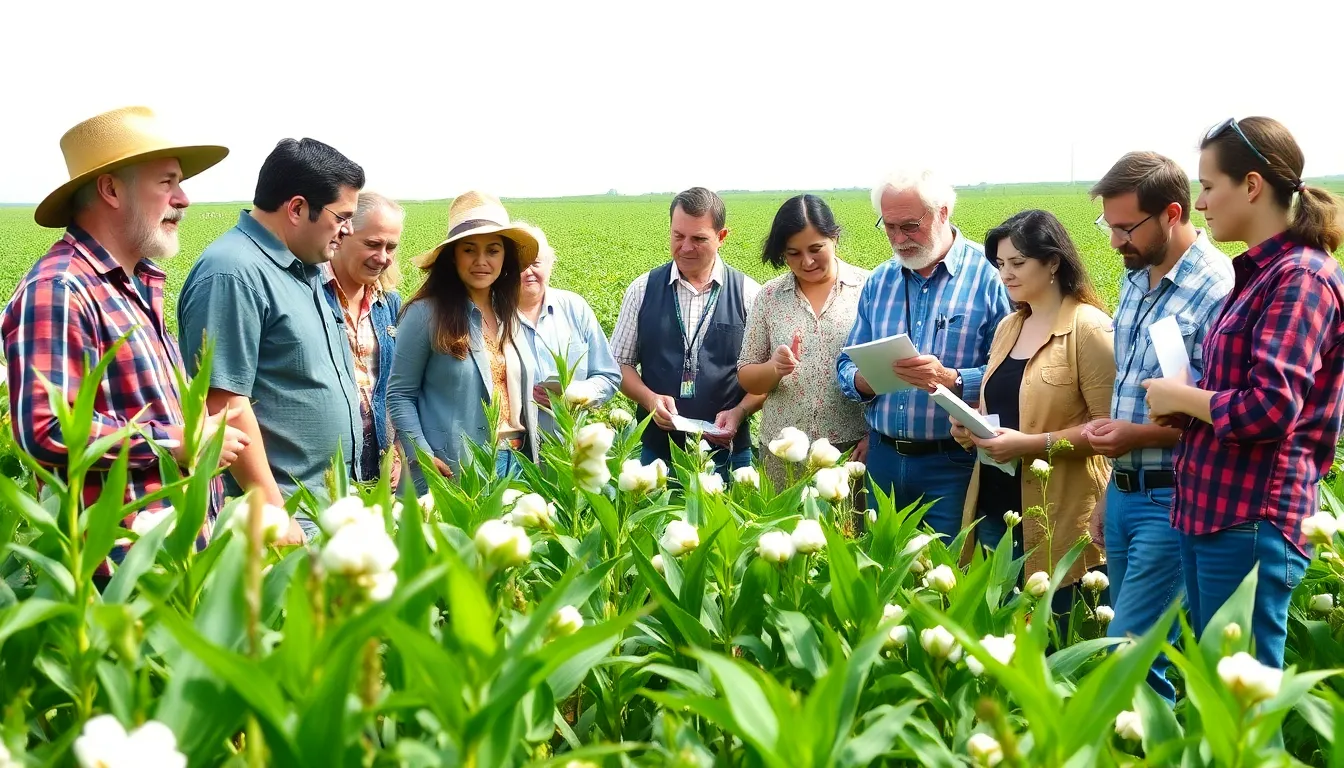The Best Fluffy Pancakes recipe you will fall in love with. Full of tips and tricks to help you make the best pancakes.

Economic Botany: Unlocking the Hidden Wealth of Plants for Our Future
In a world where plants aren’t just for decoration, economic botany emerges as the unsung hero of our daily lives. Imagine a realm where every leaf and petal has a financial story to tell. From the humble coffee bean fueling morning meetings to the cotton that wraps around our favorite t-shirts, plants play a pivotal role in the economy.
Economic Botany
Economic botany studies how plants contribute to human life in various sectors, including agriculture, industry, and medicine. This field examines plants’ roles as sources of food, fibers, medicines, and various materials that drive economies. For instance, maize and wheat dominate staple crops, providing essential calories for billions globally.
Fruits such as bananas and apples represent vital sources of nutrition while generating substantial income for farmers. Plants also supply raw materials for textiles, with cotton and flax forming critical components in the clothing industry.
Additionally, many plants serve medicinal purposes. Morphine from poppy plants and quinine from cinchona trees highlight the importance of plant-derived compounds in pharmaceuticals.
Economic botanists analyze the agricultural practices that enhance plant productivity and sustainability. They assess how traditional knowledge and modern techniques can improve crop yields while maintaining environmental health.
Furthermore, the industry relies on plants for biofuels, such as sugarcane and corn, which significantly impact energy production and consumption. The growing interest in sustainable sources emphasizes the role of plants in combating climate change.
Global trade relies heavily on plant products, with countries exporting and importing sizable quantities of crops, fruits, and other plant-derived goods. Understanding economic botany’s scope reveals the significant interconnections between plants and human actions, ultimately shaping economies worldwide.
Historical Context

Economic botany has deep roots in human civilization, showcasing the essential relationship between people and plants over time.
Ancient Uses of Plants
Ancient societies utilized plants extensively for food, medicine, and textiles. Archaeological evidence shows that early humans domesticated wild crops like wheat and barley over 10,000 years ago. These staple crops sustained large populations and influenced settlement patterns. Medicinal applications also emerged, with plant extracts serving as remedies for ailments. Historians note that cultures like the Egyptians relied on plants such as garlic and frankincense for health benefits. Textiles originated from fibers like flax and cotton, forming the basis for early clothing. The knowledge of plant uses spread with trade, enriching various cultures and shaping economies.
Development Through Time
Over centuries, practices in economic botany evolved significantly. The agricultural revolution marked a pivotal change, introducing systematic cultivation techniques. By the 18th century, advancements in plant classification and taxonomy emerged, driven by botanists like Carl Linnaeus. Colonial expansion accelerated the exchange of plants between continents, enriching diets and industries. The 19th century brought industrialization, enhancing the extraction of plant resources for pharmaceuticals and textiles. Recent developments focus on sustainable practices and biotechnological innovations, reflecting the ongoing importance of plants in modern economy and environmental stewardship.
Key Areas Of Study
Economic botany encompasses various fields, focusing on the relationship between plants and human life. This section explores key areas like medicinal and agricultural plants.
Medicinal Plants
Medicinal plants play a critical role in modern medicine. Many pharmaceuticals derive from plants, with compounds like morphine sourced from poppy plants. Quinine, extracted from cinchona trees, treats malaria effectively. Herbal remedies also offer alternatives to synthetic drugs. Research continues to identify new medicinal properties in plants, contributing to healthcare advancements. Traditional knowledge about plant use informs ongoing studies, leading to innovative treatments. Effective applications in contemporary medicine demonstrate the enduring significance of medicinal plants.
Agricultural Plants
Agricultural plants form the backbone of global food systems. Staple crops like maize and wheat provide essential calories for billions worldwide. Farmers depend on crops, such as rice and potatoes, for livelihoods and food security. Crop diversity ensures resilience against pests and diseases, promoting sustainability in agriculture. Innovations in agricultural practices enhance productivity, aligning with environmental stewardship. Economists analyze market trends to understand how agricultural plants influence economies. Significant investments in research support the development of improved crop varieties, further driving agricultural success.
Economic Importance
Economic botany plays a crucial role in shaping economies globally and locally. Plants significantly influence trade and provide livelihoods for numerous communities.
Impact On Global Trade
Economic botany heavily impacts global trade dynamics. Commodity crops such as coffee, cocoa, and cotton generate billions in revenue annually. Exporting countries rely on these plants to establish economic stability. Many developing nations derive a large portion of their income from trading these agricultural products. As trade routes expand, the demand for diverse plant products increases, further stimulating economies worldwide. Countries specializing in unique plants can seize market opportunities. Global supply chains also enhance connectivity between producers and consumers, fostering mutual economic growth.
Role In Local Economies
Local economies thrive through the contributions of economic botany. Agricultural plants directly support smallholder farmers by providing essential food and income sources. Jobs in rural areas often stem from cultivating and processing these crops. Diversification in local farming practices leads to resilience against market fluctuations. Communities benefit from selling specialty crops, such as organic fruits and vegetables, directly to consumers. Additionally, local markets and cooperatives facilitate stronger economic ties among producers, allowing for shared resources and knowledge. Cultivating native plants also emphasizes cultural heritage and promotes sustainable practices, enhancing overall community well-being.
Current Research Trends
Research in economic botany emphasizes sustainable practices and biotechnology’s role in enhancing plant products. This ongoing exploration addresses pressing global challenges.
Sustainable Practices
Sustainable practices remain a key focus within economic botany research. Implementing crop rotation reduces soil depletion, enhancing land productivity. Incorporating agroforestry systems integrates trees with crops, promoting biodiversity. Organic cultivation methods utilize natural fertilizers, minimizing chemical use. These practices help secure food sources while preserving ecosystems. Additionally, research highlights the importance of native plant cultivation in promoting local resilience and cultural heritage. Communities benefit from sustainable practices that foster ecological balance and economic stability.
Biotechnology In Economic Botany
Biotechnology plays a pivotal role in advancing economic botany. Genetic modification contributes to developing pest-resistant crops, reducing reliance on chemicals. Additionally, tissue culture technology enables the mass propagation of valuable plant species. This method conserves genetic diversity, ensuring the survival of economically significant plants. Research into bioinformatics identifies plant compounds for medicinal purposes, streamlining drug discovery. Furthermore, biotechnology enhances the nutritional profile of staple crops, addressing malnutrition in developing regions. These advancements position economic botany at the forefront of sustainable agriculture and innovation.
Conclusion
Economic botany stands as a vital field that intertwines the natural world with human progress. Its impact is felt across various sectors including agriculture, industry, and medicine. By understanding the economic value of plants, societies can foster sustainable practices that not only support livelihoods but also protect the environment.
As research continues to evolve, the focus on sustainable methods and biotechnology will likely shape the future of agriculture. Embracing these advancements ensures that the relationship between people and plants remains strong, promoting resilience and cultural heritage. Ultimately, economic botany is not just about plants; it’s about enhancing lives and building a sustainable future for generations to come.
